Introduction
In 1852 Thomas Chippendale snr left his four boys ranging in age from 11 to 18 years in charge of his newly acquired, and now famous NSW grazing property, Bolaro. What could possibly go wrong? Well a great deal in fact. The youngest brother went missing. The two older brothers went broke and along with their younger brother took to horse stealing. When the brothers finally came under the police radar and gaol time looked inevitable they planned and successfully executed the ultimate getaway. Meet the Chippendales of Bolaro, William, Thomas, Charles and James.
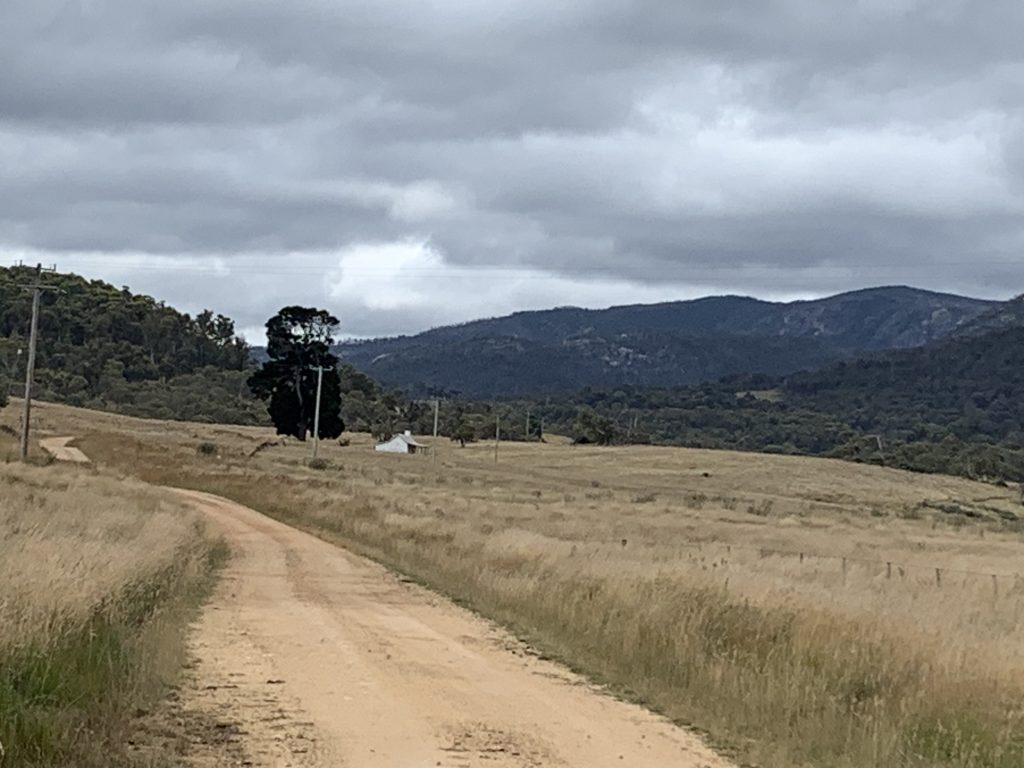
The Father – Thomas Chippendale snr
Before acquiring Bolaro in 1852, Thomas Chippendale snr had worked his nearby Naas run since 1837. However, instead of moving to Bolaro with his wife Mary Ann Herbert and all their family after the purchase, he installed his four eldest sons on the new property; William (18), Thomas (16), Charles (13) and James (11).
Thomas moved the rest of his family, mainly daughters, back to old family territory in Campbelltown where he and Mary Ann had both lived before marrying in 1833.
Soon after their return to Campbelltown, Mary Ann gave birth to a sixth son on 1 January 1853. As the newest member of the family since the Bolaro acquisition the baby boy was honoured with the name Albert Bolaro Chippendale.
Pillars of the Campbelltown Community
Thomas snr, highly regarded in the Campbelltown community, was made a senior police magistrate in 1861. His father, William Chippendale, was once Chief Constable of Appin, an area close to Campbelltown. This son and father were staunch upholders and enforcers of the law, keeping the Chippendale honour intact.
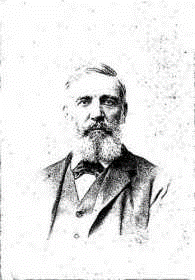
However, while Thomas snr was maintaining and building up the Chippendale reputation in Campbelltown, his sons in the Monaro were tearing it down. Within a couple of months of Thomas snr becoming a magistrate, sons Thomas jnr and Charles had warrants out for their arrests on charges of horse stealing.
Trouble Begins for the Chippendales of Bolaro
William and Thomas jnr fell into financial difficulties in the early 1860s. They owned stores in Cooma and Kiandra, which they had set up to take advantage of the new gold rush in Kiandra. A rush that lasted for about a year. Their business involved supplying rations to the diggers on the Kiandra goldfields which made perfect business sense. Under normal circumstances a business like this would have done well if Kiandra was an easy place to get to from Cooma, but it wasn’t.
Carting supplies to Kiandra was a precarious venture, difficult enough when weather conditions were good, but near impossible when weather conditions turned ugly especially when the Snowy Mountains winter rolled in. For some reason the Chippendales chose to take their drays over the dodgy and boggy Yaiak (now Yaouk) plains.
A horseman taking the same route as the Chippendale dray said the only way to get his horse up and moving again after becoming bogged was to totally unburden it. In a letter to Mr W Chatfield of Goulburn dated February 26th 1860 and published in the Goulburn Chronicle on 7 March 1860, Mr C Cowper jnr wrote:
“From Yaiak the road is very fair for five miles when you come onto the plains (so called) which are nothing but a series of bogs. I think they must have been large lakes some years back. They are covered with large rocks, similar to those at Lake Bathurst. Chippendale brings his drays in over these boggy plains, but you may fancy the state of them when our horses bogged and could not get up until we had taken everything off them.” SMH, 10 March 1860, p 5
It was not an easy route and delays and spoilage from getting bogged, which sounded inevitable, would soon eat into profit margins.
Declared Insolvent
Whether it was the tricky route, late and/or damaged supplies or slow paying creditors, their business (trading as W & T Chippendale), was declared insolvent on 1 August 1860, less than a year after gold was discovered in Kiandra. They owed £2339 – a lot of money in 1860 – with a meagre £372 in assets. The Chippendale boys were in a whole lot of trouble which triggered an unfortunate chain of events ending with Thomas and younger brother Charles’ descent into horse stealing.
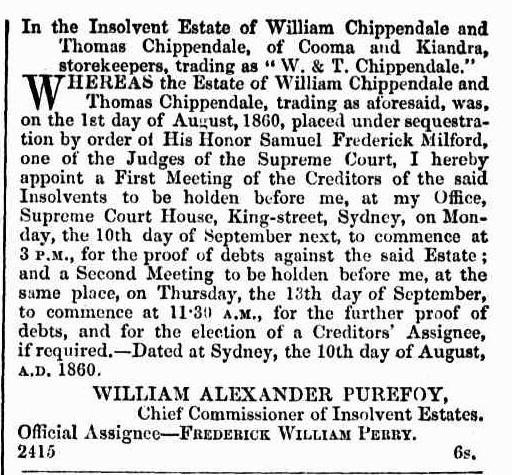
James Chippendale Goes Missing
At this point of the story in 1860, James, the youngest brother was no longer in the picture. Tragically, he went missing in Tantangara in 1856 while searching for one of his horses in dense bush. He was 15 years at the time and his story has distant parallels to Melissa Caddick’s fate.
The first search party had no luck finding James but a year later two stockmen out on Nungar Hill in Tantangara came across a boot containing the grisly remains of a foot. Another search party found human skeletal remains half a mile away.
Forty years later a human skull discovered half a mile to the north of the original gruesome boot discovery was a new lead. Gaps in the jaw from missing teeth, and a fair hair, confirmed the skull belonged to James Chippendale bringing the case to a close after forty years.
Goulburn Evening Penny Post reported in 1896:
QUEANBEYAN. [FROM LOCAL PAPERS.] A HUMAN skull has been found by Messrs. A. Witts and Bell on the slopes of the Tantangara Mountain. There are strong reasons for believing that this is a portion of the remains of a young man named James Chippendale, who lived at Bolaro, and was lost nearly forty years ago. (Goulburn Evening Penny Post, 12 March 1896, p4)
Two decades later in 1921 two versions of the story were recalled and published. One in Smith’s Weekly and the other in The Bombala Times.
The Bombala Times – “Old Time Tragedy”
The ‘ Adaminaby Advocate’ recently published the following account of an old time tragedy, as given by one who had a clear recollection of the occurrence : —
” Seventy odd years ago Bolairo Station was owned by Mr. Thomas Chippendale, who was police magistrate at Campbelltown, and his four sons, James, Charles, William, and Thomas, resided at Bolairo. About the fall of ’56 or ’57 the four brothers, with others, started for Port Phillip with a mob of 1000 bullocks, travelling by way of Lobb’s Hole and Tumbarumba. From the latter place James Chippendale started home with the spare horses, and when about Tantangara one pack horse knocked up and James placed the saddle in a hollow tree and turned the horse loose. Some days after he left Bolairo to search for the missing horse and never returned. His absence did not create any alarm at the homestead, until a man named Power, who was building a hut at The Gulf, near Nungar, one day saw a horse with a saddle on it amongst a mob of quiet horses belonging to Mr. West of Cabramatta. Investigations showed that the mare with the saddle on was the one which James Chippendale was riding when he left home. A search was immediately organised but nothing of the missing man was found.
“In the following spring two men named King and McFadden were looking for cattle about Nungar, and in leading their horses down Nungar Hill, King stepped over a blucher boot which McFadden picked up, and to his horror discovered a human foot inside the boot. As soon as the gruesome find was reported, residents from all round formed a search party to endeavour to find the rest of the remains, and about half-a-mile in a northerly direction from where the boot was found a thigh-bone and some pelvic bones were discovered. These bones were buried near where they were found.
“About 20 years afterwards a party of horsemen, including a Mr. Burke, at that time postmaster at Kiandra, and Archie Bell, found a human skull at a spot about half-a-mile in a northerly direction from where the boot was found. A hole in the skull contained a fair hair, and this, with some gaps in the jaw where teeth were missing, was all that could be found to show that the skull belonged to the missing man. The skull was buried near Witts’ hut.’ (The Bombala Times, 15 July 1921, p2)
Smith’s Weekly – “CHIPPENDALES LAST CHASE”
B. Cross provides a more sensational take on the fate of James Chippendale even claiming that Barcroft Boake wrote his famous poem On The Range featuring “The Lord of The Hills” to describe the tragic event. Boake’s poem, however, was clearly written about the daring and heroic horsemanship of Charlie McKeahnie, the son of a later owner of Bolaro Station, Alexander McKeahnie.
The old days of brumby running in the mountains surrounding Kiandra (N.S.W.) provided many a day’s sport and excitement to the bushman of sixty years ago.
From time to time blood horses escaped from the studs of the Upper Murray, and Maneroo, and these founded a breed of wild horses which, were eagerly sought after by the bush-men of the day. Parties were organised and stockmen from near and far joined the ranks of the brumby hunters, to yard the mobs in the trap-yards built for the purpose.
Often, too, a solitary bushman riding through the ranges, would suddenly come upon a mob of these horses. Instantly, he would jam in his spurs and give chase, in an endeavour to head them for some trap-yard. It was with these solitary hunters that danger and death so often rode. One false step taken by the horse, one overhanging bough not quite soon enough dodged by the rider, and a lonely and often lingering death in the mountains was the result.
Such a death met Chippendale, from whose tragic fate Chippendale’s Ridge on the Nungar takes its name. Chippendale rode out from Adaminaby to visit a friend beyond Tumbarumba, about 80 miles away. It was his last ride. He was never again seen alive.
A week or more passed and nothing being heard of him his friends became anxious, a search party went after him. When crossing the Nungar, they saw and yarded a mob of brumbies. Among them was Chippendale’s horse with the saddle under its belly, and— gruesome sight— a Wellington boot with a human foot still in it, hanging fast from the stirrup.
This gruesome relic removed all doubt as to the fate of Chippendale, and splitting up, the party scoured the countryside in an endeavour to find the remains of the unfortunate man. After days of weary search; another leg with boot still attached was found, and a little later the headless trunk was discovered lying under a log on the top of the ridge which now bears his name.
All efforts to locate the head were unsuccessful, and the poor shattered remnants were interred. The supposition was that Chippendale; falling in with a mob of brumbies had given chase, and his mare, always flighty, had dashed him into a tree and unseated him, in falling his foot had become fast in the stirrup iron, and he was then dragged in among the terrified horses and literally torn to pieces. About thirty years later a human skull was found, on the Nungar, not far from the spot where the headless trunk had been discovered. It was lying out on a large, flat rock, where it had apparently been dragged by the dingoes. Old hands who knew Chippendale, identified it as his by some missing teeth gaps, but it was never absolutely proved to be Chippendale’s skull.
For some time it could be seen by the curious, standing on a shelf at the old Tantangara homestead, here it was eventually buried in the garden. Incidentally the scene of this tragedy is described by Boake, in his poem, “The Lord of The Hills.”
— ‘B. Cross.” (Smith’s Weekly, Saturday 21 May 1921, page 19)
The Chippendales of Bolaro Horse Stealing Ventures
Thomas jnr and Charles Chippendale were first suspected of being involved in a horse stealing racket when twenty horses went missing from a property directly over the river from Bolaro in April 1861. Although they avoided arrest at the time, two males who worked for them didn’t. One of them was George Watson, a twelve year old boy, who rode for Thomas Chippendale at the Cooma races. Charles employed the other male, Thomas Green.
Watson and Green claimed a man they called ‘the master’ hired them as drovers and they pleaded “not guilty” at their Albury trial in June 1861. ‘The master’, they said also went by the name of ‘Tom’. Thomas Chippendale most likely.
Their pleas of “not guilty” didn’t wash well with the jury who found the pair guilty of receiving stolen property. His Honour Judge Callaghan sentenced Watson and Green to three and five years hard labour respectively. Because he was only twelve years old Watson was shown some leniency and received a shorter sentence of three years in Goulburn Gaol compared with Green who was put to work on the roads for five years.
The master minds were in all probability Thomas and Charles Chippendale.
Father, Thomas snr, Reacts
Not long appointed a magistrate in Campbelltown, Thomas snr obviously concerned, and probably deeply embarrassed, wanted more information. Eldest son, William, went to pains to assure him that:
“There is at present no evidence sufficient to convict either of my brothers.”
William’s assurance was mentioned in a letter from Thomas Chippendale snr to Thomas Locker of Happy Valley, Adaminaby. However there are indications in the same correspondence that Thomas snr had an inkling something nefarious was brewing. Neville Locker, still has the letters from Thomas Chippendale snr to his G Grandfather, Thomas Locker. One dated 16 May 1861 has Thomas Chippendale snr giving Thomas Locker authority to:
“ … look after the place (Bolaro) until something turns up.”
He also informed Thomas Locker that he had written to Charles:
“ … telling him what I have said to you. I have also written to him to immediately discharge that woman Mrs. Bryan, I particularly request for you to see that she is sent away. You have my authority to do so. I have also to request Mrs Locker be kind enough to wash for Charles in her absence. Ask Henry (Locker) to keep a look out about the Station on my account.”
So, who was Mrs Bryan? Or “that woman” as Thomas snr refers to her? Was she leading Charles astray? Her name pops up later in the Albury court where she is referred to as Mrs O’Bryan.
Arrest Warrants Issued for Thomas and Charles Chippendale
The following month, June 1861, warrants were out for the apprehension of both Thomas and Charles Chippendale as accomplices to the horse theft. Cooma police arrested Charles and escorted him to Albury to face charges.
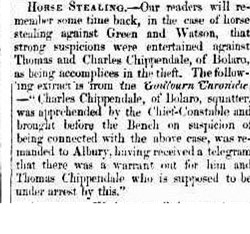
The court granted Charles bail. Somewhat prematurely in hindsight, as another warrant for his arrest on separate horse stealing charges in Kiandra soon emerged. Entry in the NSW Police Gazette of 1861 said:
“KIANDRA – a warrant has been issued for the apprehension of Charles Chippendale charged with stealing a horse, the property of William Murphy, of Nine Mile Creek, near Kiandra. He is about 22 or 23 years of age, 5 feet 9 inches high, fair hair, no whiskers, stout build, generally wears a black monkey jacket and cabbage tree hat. The horse has been recovered.” (Ancestry.com, NSW Australia, Police Gazettes, 1854-1930 [database on line] Lehi, UT, USA. Ancestry.com Operations, Inc., 2010)
Unsurprisingly, Charles soon found himself in police hands again.
The Chippendales of Bolaro Use False Identities
Thomas jnr, meanwhile, disappeared into thin air. In 1863 a shrewd detective, named Thomas Coward, recognised him in Bathurst going by the name of Charles A. Thompson. No time was wasted and Thomas Chippendale was arrested on charges of horse stealing which occurred nearly three years earlier in the Monaro.
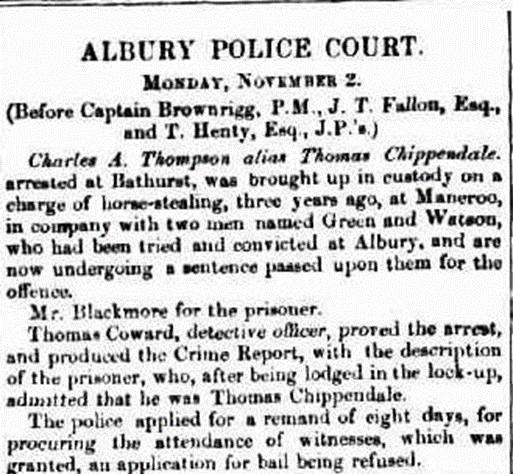
The NSW Police Gazette 1863 stated:
“Albury Gaol / Charles Thompson alias Thomas Chippendale / Offence – Stealing a mob of horses. / Sentence – Admitted to bail.” (The NSW Police Gazette 1863 [Issue No. 49] p. 376)
Both Thomas jnr and Charles Chippendale were committed to trial on horse stealing charges which dated back to the 1861 episode and which related to the Thomas Green and George Watson case mentioned earlier.
Handwriting Experts Called In
Several witnesses were called to the trial among them handwriting experts, called because Charles was suspected of writing cheques to himself and Mrs O’Bryan (“that woman”) using the name ‘Frank Hilton’.
A Not Guilty Verdict
Incredibly, despite the evidence that seemed to point to their guilt, the Attorney General in February 1864 declined to proceed with the prosecution. Rather than seeing this as a lucky escape the Chippendale boys continued with their unlawful ways.
Wedding Bells – Thomas Chippendale jnr Marries Charlotte Webb of Uriarra
Horse stealing aside, Thomas falls in love with Charlotte Webb, daughter of the respected Uriarra grazier, George Webb. On 24 July 1865 Charlotte marries Thomas at Christchurch Queanbeyan, against her father’s wish according to Samuel Schumack.
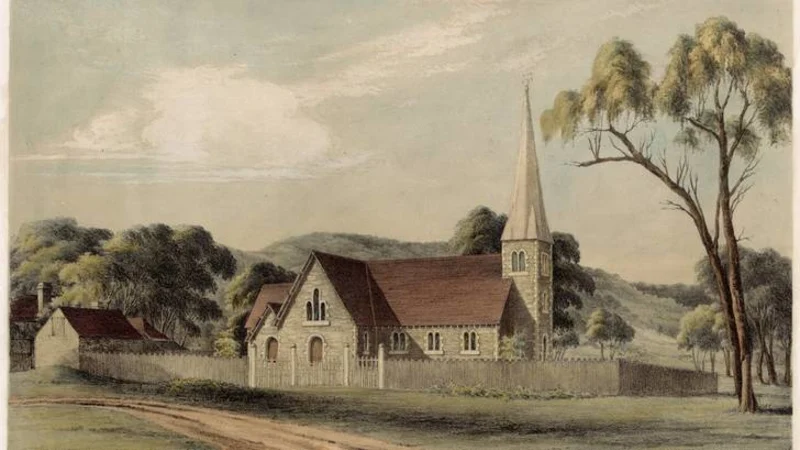
The Webb’s Historic Connection to Canberra
Charlotte’s parents, George and the Sarah Webb of Uriarra, are buried in the churchyard of St John the Baptist, Reid. Mother, Sarah died at age 33 years, giving birth to Charlotte, her tenth child. The parents and some other family members lie beneath the famous ‘Prophetic Headstone’ which bears the inscription “For here we have no continuing city but seek one to come”. The words from the Epistle to the Hebrews, Chapter 13, verse 14 certainly fulfills a vision when it comes to present day Canberra, the nation’s capital city.
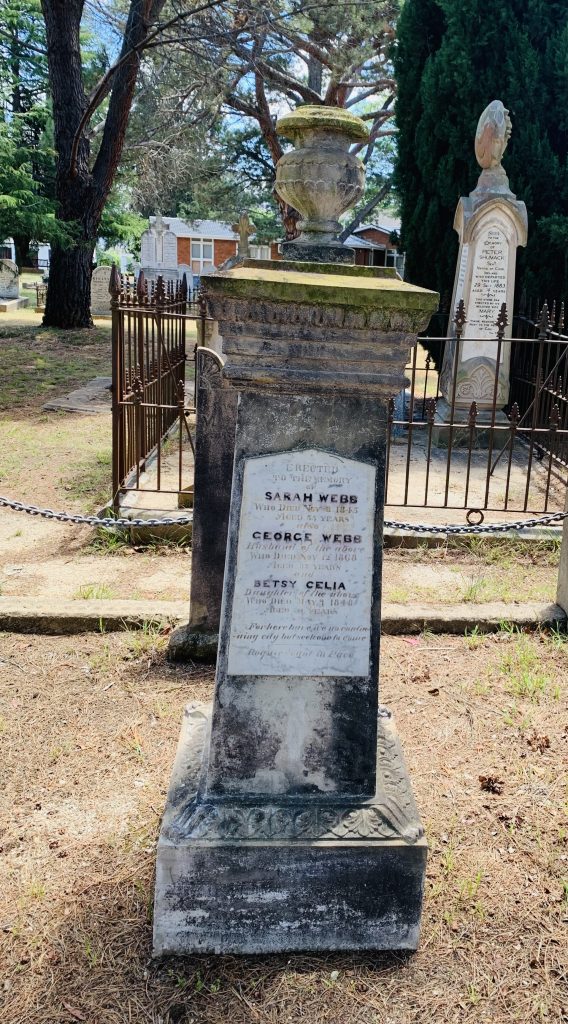
Marriage Doesn’t Quell the Horse Stealing Urge
Thomas’ horse stealing continued unabashed. Less than a year after his marriage he was again mentioned in the NSW Police Gazette. A racing mare had caught his eye in Bathurst as well as some other horses which he purloined. He was soon committed to trial for stealing and subsequently bailed.
” Vide Police Gazette 24 January and 7 February 1866, pages 29 and 46.
Thomas Chippendale, charged with stealing the horses Nos 4 and 7 in the 1st of the above references (recovered), the property of George and Wm Lee, has been arrested by Senior Constable Bryan, Seymour (Adaminaby most likely) Police. Remanded to Bathurst. This offender is further charged with stealing, at Bathurst, a horse, the property of Thomas Ivory , Sydney.” NSW Police Gazette, 14 March 1866, page 97.
Thomas failed to appear in Goulburn Court when called upon and a bench warrant was issued for his arrest.
The entry in the NSW Police Gazette, 17 October 1866, page 374 read:
“A Bench warrant has been issued for the arrest of Thomas Chippendale, junr., charged with absconding from bail, and failing to appear at the Circuit Court, Goulburn, on the 8th instant, to answer a charge of horse stealing. He is supposed to have gone to the Gulf of Carpentaria.”
He was really in trouble now having been charged with absconding from bail and failing to appear on horse stealing charges. A gaol sentence looked inevitable.
The Ultimate Getaway for the Chippendales of Bolaro
Police were wrong believing Thomas jnr had gone north to the Gulf of Carpentaria. In fact, he and Charlotte had gone much further afield. They didn’t die in a ship wreck as people were led to believe in Samuel Shumack’s story in his Tales and Legends of Canberra Pioneers.
“Mrs Julia Webb gave me the particulars of the death of Mrs Webb, and she was present when the incident referred to took place. There is a sad story about the infant daughter Mrs Webb left behind when she died. I have no recollection of having seen the child, although I know that she grew into a splendid type of woman. It was her father’s wish that she marry Alexander Cameron, and I often saw him leave his home on Saturday to visit Miss Webb at Uriarra. In 1866 all the neighbours were surprised to hear that she had married a young man named Chippendale, much against her father’s wishes. The ceremony took place in Queanbeyan, after which the young couple journeyed to the Clyde River on the eastern coast and embarked on a small vessel for Sydney. After a brief stay in the city they embarked on the Cawarra for Newcastle, where the vessel was wrecked on Nobbys with the loss of all hands but one.”
Thomas and Charlotte, were not on board the Cawarra. The ship’s list of deceased persons confirms this.
America Bound
The couple instead flee to the United States using the surname ‘Herbert’, Thomas’s mother’s maiden name. We learn from Thomas’ death notice in a US newspaper that he and Charlotte under their alias ‘Herbert’ sailed from Sydney to America in 1866 aboard an old sailing vessel, the Douglas and became pioneers in Monterey County, California where they raised a daughter and three sons.
Death of Thomas Chippendale alias Herbert
While little is known about Thomas and Charlotte’s actual life in America two articles uploaded to Ancestry.com by subscriber, Geoff Turner on 25 July 2021 and 29 May 2022 reveal the tragic story of Thomas’ death. The article gives graphic details of Thomas’s suicidal death from a gunshot wound to the head inflicted by a revolver he bought in a hardware store in Soledad. He died on 27 March 1912.


TRIBUTE TO LATE THOS. C. HERBERT: “Thomas C. Herbert was born Sept. 27 1836 in New South Wales, Australia, and was one of a family of 12 children. His father was a native of England, his mother a natural born Australian. He was married in 1865 to Miss Charlotte Webb of the same province and came to America in 1866 in an old sailing vessel, Douglas, built by Lady Franklin to go to the Arctic in search of her husband, Sir John Franklin.
In those days there were no steamers and they were 83 days making the trip from Sidney (sic) to San Francisco.
They lived at Salinas a while, the Sherwood ranch, and then on Pleyto a short time, but most of his time was spent on the ranches in the Reliz Canyon. A few years ago he and his son, Eugene, moved to a place they bought in Agenda county, but for the last few months he stayed in Salinas where he could receive medical aid.
For twelve years he has been a sufferer. He was afraid of being a burden to some one and knew it was only a matter of suffering to the end, which he said he thought was not far off. Hence his rash act which was committed in the town of Soledad, Wednesday March 27. His daughter-in-law had taken him to town, to try and get relief for him, where he procured a revolver. He shot himself in the right temple and died instantly.
He leaves the following relatives. A daughter, Una G Pettitt of Arroyo Seco, Eugene V (Vincent) Herbert of Salinas, Stanley W (William) Herbert of Reliz, Garnet W (Wallace) Herbert of King City, besides a niece, Ada Augusta O’Donnell (nee Herbert, Charles’ daughter) of Sacramento, and two nephews, Horace Henry Herbert and Charles Chippendale Herbert.
He was 75 years and 6 months old on the day of his death.
Death of Charlotte Chippendale nee Webb Alias Herbert
Charlotte died on 17 August 1921 at 78 years, outliving Thomas by nine years. The following obituary was uploaded to Ancestry.com
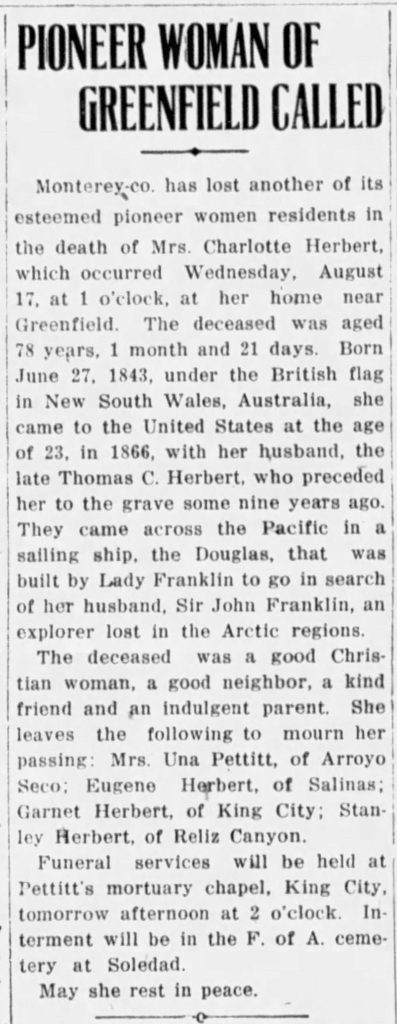
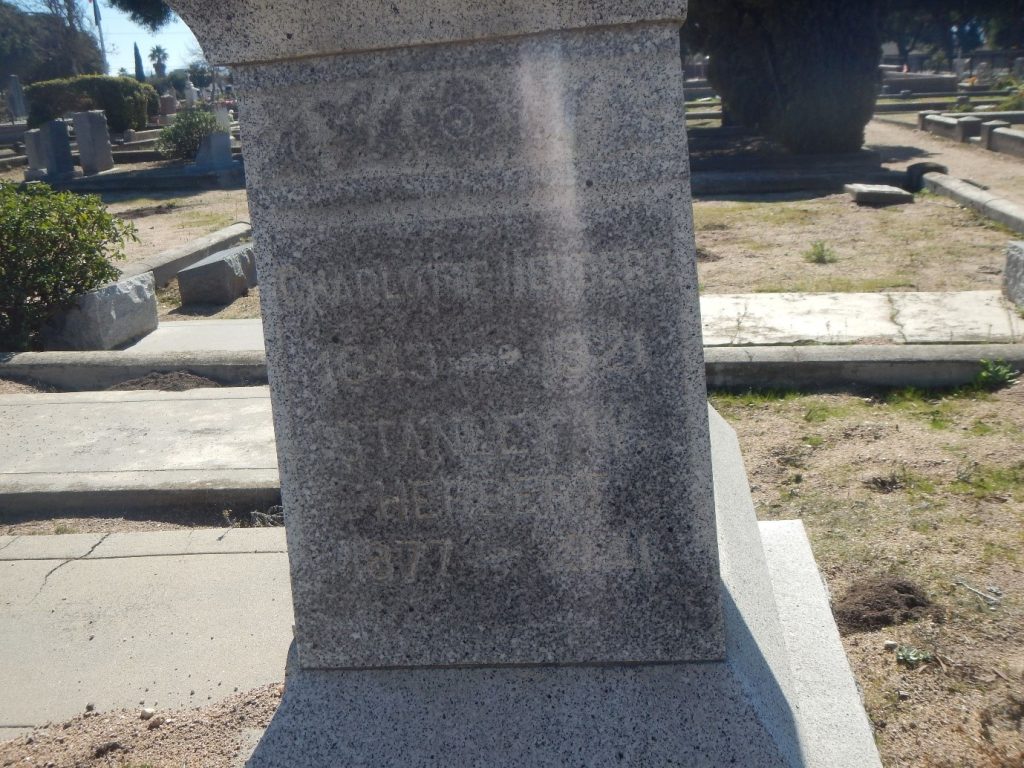
Charles Chippendale – Later Known as Charles Herbert
Younger brother Charles also made his way to California and married Sarah Emma Melton, thirteen years his junior on 31 October 1877.
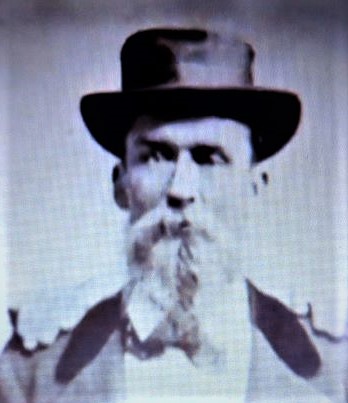
Tragically five years after his marriage Charles dies on 8 December 1882 at 43 years, before seeing his fourth child and namesake Charles Chippendale Herbert born.
In a double tragedy for the family Sarah dies on 25 August 1883 less than a year after her husband and two months after the birth of her fourth child leaving behind four children under four years of age: Horace, Ada, Sarah and baby Charles.
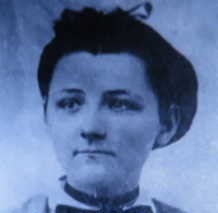
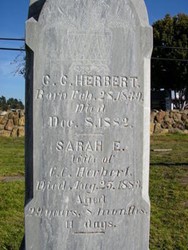
What Happened to William Chippendale?
William made his way up to Queensland. He certainly didn’t stay around the Monaro. Apart from the fact that the Chippendale name was probably out of favour in the district, his father Thomas snr handed over the Bolaro property to his brother-in-law William Herbert in 1866. Thomas snr was probably keen to erase Bolaro and the lawless activities of his sons from his memory and save what he could of the Chippendale reputation.
Whether William was caught up in the horse stealing racket with his brothers is open to speculation – possibly guilt by association. Some of the old Monaro locals may have suspected his involvement. Rumour was about that he was mixing in circles of thieves and that he was involved in the stealing of a grey gelding at Millie in Northern NSW and later arrested in Tambo, Queensland.
Ironically, considering his brothers were thieves and that he himself had been bankrupt he was appointed the nuisance inspector and bailiff in the Small Debts and District Court at Longreach.
Death of William Chippendale
The Western Champion and General Advertiser for the Central-Western Districts published William’s obituary on Sunday 16 August 1903:
Death of Mr. W. Chippendall.
General regret was expressed in Longreach when it became known that Mr. W. Chippendall had succumbed to a lingering and painful illness. The deceased was born in 1834 at Liverpool, near Campbeltown (sic), in New South Wales, but his boyhood was spent on his father’s station in the Monaro district.
Very many years ago he came over with cattle to Beaufort, near Alpha, and was in charge of Coligny, an outstation of that place. He made several trips down to New South Wales, but invariably returned to this State.
He and his brothers had several racehorses, which they raced in what were then the back blocks. All of them were great horsemen, and Mr. Chippendall was also engaged in carrying out in these parts.
Finally he went to Croydon, but was very unsuccessful there, meeting with a series of misfortunes. He left there broken down in health and very much poorer than on his arrival. He drifted to Longreach, and was one of the earliest settlers here.
Mrs. Chippendall had a school here, and there are many in Longreach whom she instructed. When Longreach was severed from Aramac Division Mr. Chippendall was appointed nuisance inspector and he was also bailiff in the Small Debts and District Court.
He carried out his duties in a thoroughly conscientious manner, and the Shire Council have lost a tried and faithful servant. The deceased was buried on Thursday, the Shire Council sending a wreath and all the Councillors and Councils’ employees in town attending as a mark of respect. He leaves a widow, for whom the greatest sympathy is felt. (The Western Champion and General Advertiser for the Central-Western Districts, 16 August 1903, page 8)
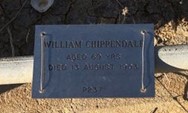
I’ll allow the ‘Old Identity’, aka Samuel Shumack have the last say on the Chippendales of Bolaro and their fate … just to add more confusion to the puzzling nature of this story. In his series “True Stories of Canberra” he wrote:
“Amongst the earliest pioneer families of Canberra were the Chippendales and Webbs, of the Swamp. The reports I heard of the Chippendales were most conflicting, but all the reports of the Webbs were excellent, I never heard word against them . . . . ” Commenting on this. “That Other Old Identity'” writes of the Chippendale family:—”On one side the mother was a Herbert, sister to good old ‘Was-em’. The father was Thomas Chippendale, sen., who, after taking up Bolara and other runs in the Adaminaby district, retired and with his wife and youngest members of his family (principally, daughters) lived the rest of his life in Campbelltown, leaving his two elder sons, in conjunction with William Herbert, at Bolara. A more honored and respected man and JP did not live in the Campbelltown district than Thos. Chippendale, sen. At the time I am alluding to, Campbelltown was the terminus of the southern railway system, some half century or more ago and in going there to meet the railway I never failed to hunt up my old friends—the Chippendale family. I have not visited Campbelltown since, but I feel quite assured that the descendants kept up the good reputation left them by their good old parents. As to the ill-repute the two sons may have obtained; anyone who took much to horse-racing in those days was sure to get ill-repute from some one. I have heard these rumours myself but whether they were justified, it is not for ‘Old Identity’ or myself to say. “At about this time, old Mr. Henry Hall, of Charnwood, used to breed some great utility horses, some of which were remarkably good on the turf as long distance weight-carriers, and as he had a run up near Bolara, where his horses were depastured in the summer months, they were well known there. The very best and most renowned of these as a straight-going winner was a grey mare, Chippendale’s Annie Laurie; I never heard of her being run crooked. “I know all about the mysterious disappearance of Thos. Chippendale, jun., and of his being caught and perishing in a blizzard of snow near Happy Jack’s Plain. These blizzards were much more sudden and severe than in the present times. I have been many times on the spot where young Chippendale’s bones and boots were found.” (Queanbeyan Age, Tuesday 25 August 1931, page 2)
An excellent and lively account, Sue! I knew the outline of the story and a few details. You have filled in many more and added colour to the account of the Chippendale family. It was a most enjoyable read. What with the Chippendales at Bolaro and the Clarke brothers further east at Jingera, the district was beset with men ready to steal horses, cows and sheep.